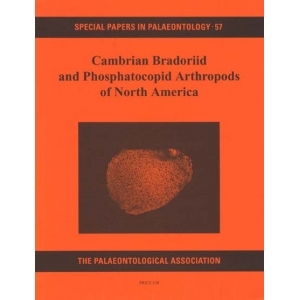
Special papers in Palaeontology: 57
<br />1997
<br />
<br />Cambrian bradoriid and phosphatocopid arthropods of North America.
<br />D J Siveter and M Williams.
<br />
<br />69 pp., 9 pls, 8 text-figs.
<br />
<br />ABSTRACT. North American species were among the first bradoriid and phosphatocopid arthropods to be documented and include many historically and nomenclatorially important taxa.
<br />The most abundant specimens of bradoriids and phosphatocopids in North America occur in the Canadian Atlantic Provinces, British Columbia and Arizona and, to a lesser extent, in New York State and Tennessee. The families Bradoriidae (junior synonym: Indianidae), Beyrichonidae, Hipponicharionidae, Svealutidae and Vestrogothiidae are represented; Escasona and the hitherto widely used A/ula are considered to be nomina dubia. The total known fauna, comprising 16 genera (including Mallhoria gen. nov.) and 26 species (including three under open nomenclature and Liangshanella burgessensis sp. nov.), is much less diverse at the specific level than indicated in previous records (about 100 species). The genera Beyrichona, Hipponicharion, Liangshanella and others have a phosphatic carapace, thus endorsing the notion that carapace composition cannot be used as a diagnostic criterion for distinguishing bradoriids from phosphatocopids.
<br />Provinciality of the bradoriid and phosphatocopid faunas supports the notion of an Iapetus Ocean in the Cambrian. Eastern Canadian (Avalonian microcontinent) faunas are characterized by Beyrichona, Cyclolron and Hipponicharion; Arizona (Laurentian palaeocontinent) has Wa/collella and Die/ymella. Bradoria is known from both the Avalonian and Laurentian parts of North America; the cosmopolitan Anabarochilina occurs only in the Laurentian part. Faunas of the distal shelf of Laurentia have Asiatic (Liangshanella and cambriids) and Australian (Indola) bradoriids.
<br />Bradoriids and phosphatocopids occur throughout the Cambrian of both the Avalonian and Laurentian parts of North America. Most species are short ranging but have only local geographical occurrence. A few species have intercontinental biostratigraphical value, being coeval in Canada, Britain and Scandinavia.
<br />The bradoriid and phosphatocopid faunas of North America occur as low diversity marine assemblages and were probably mostly benthic or nekto-benthic. Shallow water cratonic sequences in Arizona and distal shelf/shelf edge deposits in Alberta, British Columbia and in Greenland (all on palaeocontinental Laurentia) have very low diversity bradoriid assemblages (one or two species). Shallow shelf sequences in New Brunswick and Nova Scotia (palaeocontinental Avalonia) contain mainly richer, but also low diversity bradoriid assemblages (three to six species). Distal shelf faunas in Newfoundland have monospecific phosphatocopid assemblages.